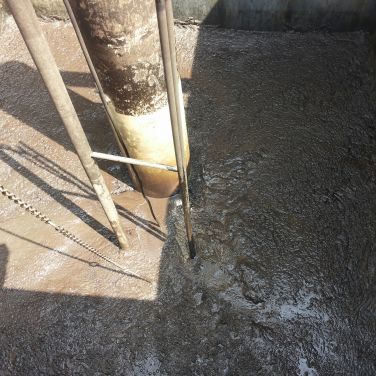BIOLOGICAL TREATMENT
All plants that carry out a biological process according to the “active mud” principle, are part of the history of the development of waste water treatments. It was in 1913 that two Britons, Ardern and Lockett, announced their “active mud” system, an idea that was then revolutionary. It developed rapidly and soon became the most versatile way to purify waste water.
As in all biological processes that use liquid, the oxygen required by micro-organisms or bacteria must be available in a dissolved state. In “natural” aerobic purification (ie: the way in which water cleans itself in a natural environment, in ponds for example) the oxygen necessary for the development of the biological reactions is made available in a dissolved state through either oxygen in the atmosphere being dissolved into the water or due to the function of oxygen-producing chlorophyll present in green algae. In “active mud” plants conditions differ to the natural environment: owing to the increased concentration of bacteria, there is not enough oxygen available from the atmosphere and, moreover, green algae cannot develop in the dense mix that characterises this type of treatment. It is therefore necessary to carry out artificial aeration.
In an environment rich in oxygen, like aeration tanks, a complete physical, chemical and, above all, biological process can take place. In the first place, a chemical oxidation of the reduced compounds (such as hydrogen sulphate, sulphides and sulphite) takes place. Then, through a physical and biological process, the large concentration of bacteria which has been growing in the aeration tank intervenes and forms a “colony” consisting of “biological sludge”, that is to say, a gelatinous mass that binds together the sedimentable solids that have escaped previous treatment. Also, the non-sedimentable colloidal solids are held together because of the physical phenomenon of absorption; this is caused by a strong movement of superficial attraction that encourages the colloidal substances to stick together and stay in clumps in the biological sludge (this is determined by the amount of surface area available for the colloidal substances to adhere to: from 2000 to 10000 m² per m³ of tank volume).
Also, during the long period of time in which the waste is inside the aeration tank, the bacteria themselves use some of the soluble organic substance present in the liquid for their own development, making them increase in size and, therefore, making them sedimentable. At the same time they start to purify the sedimentable and colloidal substances, which are bound together in the biological sludge.
This results in a net increase in both bacteria and the sludge in which they are bound which then passes through the waste water in the following sedimentation stage. The sludge is collected in the bottom of the tank while the cleaned water overflows it into collection channels. The clean water can then undergo further treatment, for example; disinfecting or water recovery, before the water is sent to its final stage. A fundamental result of biological treatment is that it turns (dissolved and colloidal) organic substance into a sedimentable state. That is to say, the organic substances are subjected to a sedimentation process, which otherwise could not be collected or removed in the liquid stage. A typical characteristic of biological processes is “to remove” the organic substance and due to this they can reduce the BOD more than chemical physical treatments.
GALLERY









